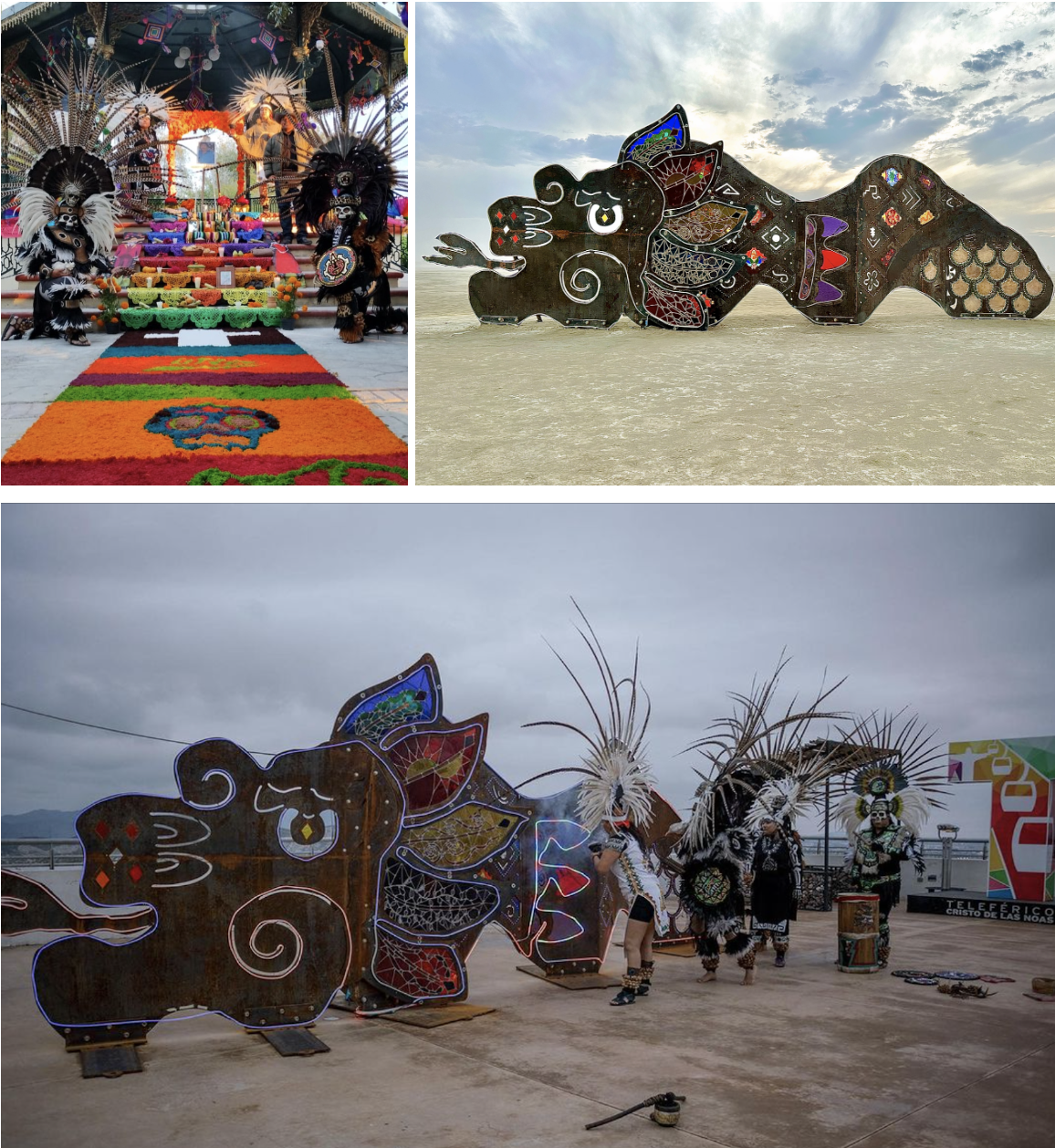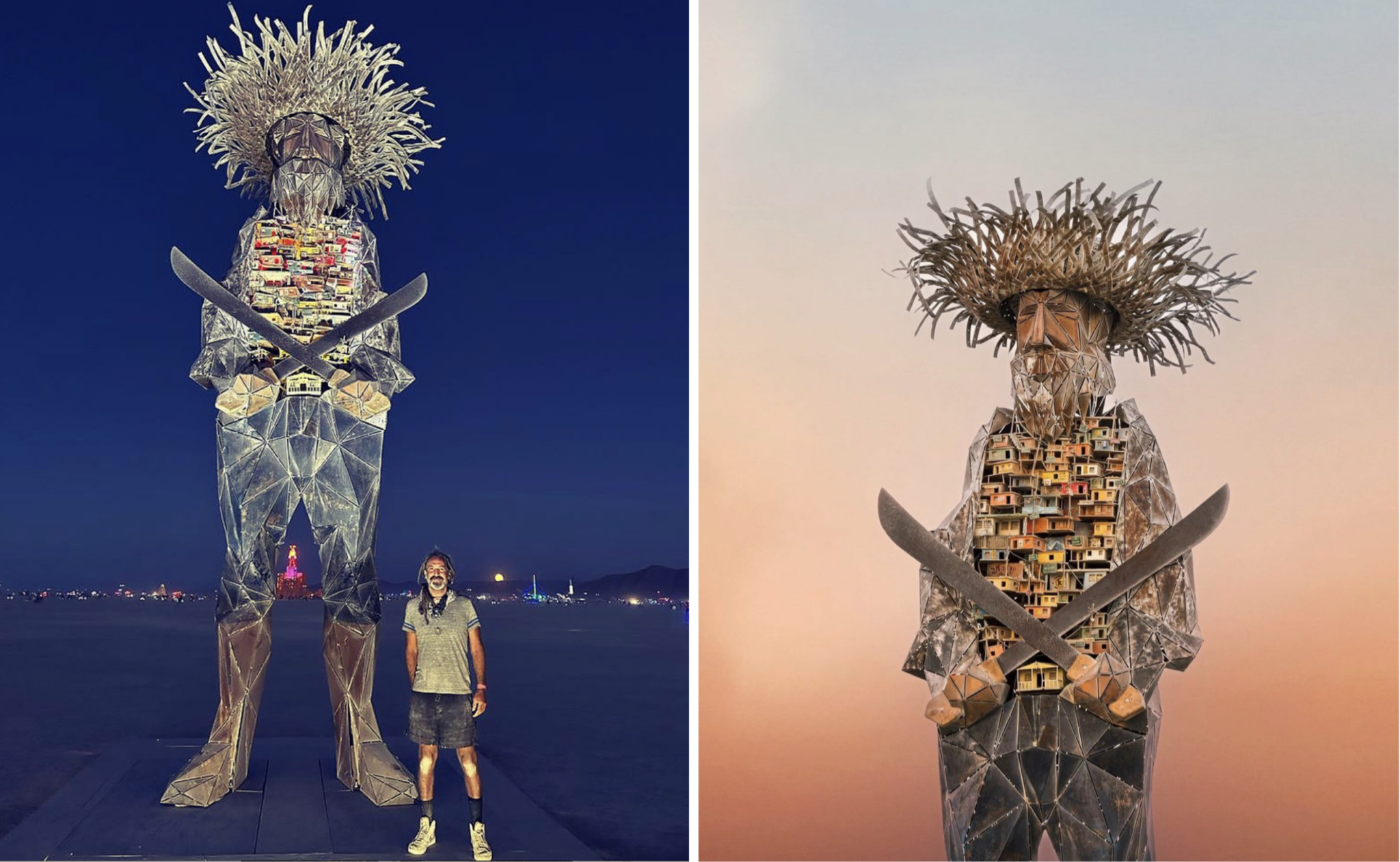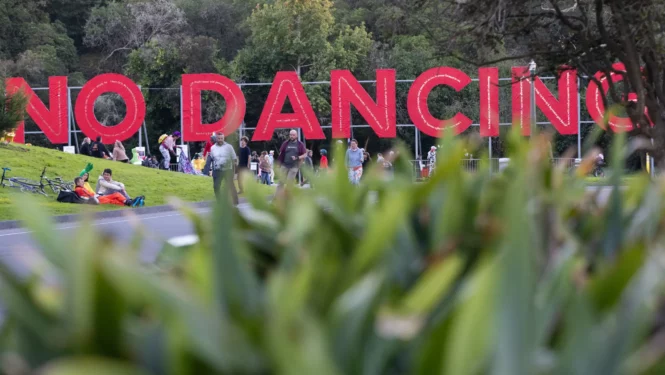The nonprofit Burning Man Project collaborates with the community to build Black Rock City, and works year-round to nurture the global Burning Man movement. We can’t do any of this without YOU. Please consider making a tax-deductible donation in support of our work building a more creative, connected, and resilient world.
Every year, hundreds of applications are submitted for Honoraria art grants. These partial-funding grants enable artists from around the world to bring their artwork of all shapes and sizes to the annual Burning Man event in Black Rock City. In 2023, 75 art projects were selected as Honoraria, supported by more than $1M in grants from Burning Man Project.
It’s not uncommon for some of these art installations to make their way from the dusty desert of Northern Nevada to locations worldwide. The impact Burning Man art is having on communities has never been more apparent — the creativity, passion, and intent behind this variety of diverse, sustainable, and powerful art might otherwise never be experienced by the communities where these remarkable installations land.
While Black Rock City is an ephemeral place in the desert that only lasts one short week, its impact extends year-round, same as the art which graces its stark desert landscape. The financial support for Honoraria from our global community helps keep this fire burning brightly.
We recently sat down with a handful of 2023 Honoraria artists to discuss their art, its impact, and the importance of bringing art out of the dust for people around the globe to engage with, beyond Black Rock City.
Leyla (Ley) Brashka: “Quetzalcóatl Reborn”
Leyla is a first-time Black Rock City artist from southern Mexico. She created “Quetzalcóatl Reborn” with co-lead Lisa Regan, a sculptor from Tulsa, Oklahoma. Lisa spends half of each year in Mexico, which is where she and Ley first met. Working in tandem, with the support of Crescent Art Collective, Ley designed the Quetzalcóatl and Lisa did the metalwork. Currently, “Quetzalcóatl Reborn” is installed on the Cerro de las Noas hill, in the Mexican city of Torreón, Coahuila, for the community to engage with.
Ley: It took a lot of people to make this piece happen. Lisa’s son, Christopher Regan, also played a very important role — he was the build lead. We worked alongside a lot of amazing volunteers — Mexicans helped create the stained glass and the drums; Americans helped build the piece with us. After Burning Man, I wanted Queztalcóatl to continue going to other places in order to share and preserve this piece’s important pre-hispanic legacy, beyond BRC.
The Quetzalcóatl is considered the most important Mesoamerican god, the one who created [hu]mankind and gave them corn. He is representative of the wide, rich history Mexican culture has. The piece was created to preserve this legacy. It is made from large sheets of metal, standing 28’ wide and 10’ high, and stained glass on the feathers and the scales, with Hispanic symbols of Mexican ancestors.
Just last month, a Día de los Muertos ceremony was held with “Quetzalcóatl Reborn” as the meaningful backdrop to this culturally important day. For me, it’s very, very important to share it and to continue taking this piece to other places.
You can learn more about the project here.

Jen Lewin: “The Ursas”
Jen has been coming to Burning Man since 1998. This is her 14th time bringing an installation to Black Rock City. She has created such memorable pieces as “The Last Ocean” (2022), “Aqueous” (2017), “The Pool” (2008 & 2009), and “Arch Harps” (2005 & 2006). To date, more than 70 of her artworks have been placed in locations all around the world. “Ursa Major” is currently installed in Brooklyn, New York, and plans are being finalized for her to be joined by “Ursa Minor” in early Spring 2024.
Jen: My plan is always for the art to travel beyond Black Rock City — the intention is for it to go out into public spaces, making it more accessible, into communities that wouldn’t be able to have the opportunity necessarily to come to Burning Man or experience the art otherwise. So I don’t think it’s important to take artwork outside of BRC, I think that it’s really important. I think it’s transformative to people’s perception of art, and I just think it’s a really special thing to do. Especially as an artist, it brings a lot of connective joy.
Together, “The Ursas” — ”Ursa Major” and “Ursa Minor” — were made out of reclaimed ocean plastic trash, to stand as beacons of unity and compassion. “Ursa Minor” gazes skyward, embodying a hopeful spirit, while “Ursa Major” serves as both a sanctuary and a memorial, paying homage to the irreplaceable species we have lost.
You can learn more about the project here.

Mark Rivera: “Jíbaro Soy”
Mark (aka Kidnetick) is an artist out of Santurce, Puerto Rico, with a passion for experiential street art. This was his first piece created for Burning Man, though his art lives in dozens of locations worldwide. Earlier this year, Mark was displaced from his home in Puerto Rico, and was literally homeless when he got the Honoraria grant and decided to come to California to build a sculpture for BRC 2023. “Jíbaro Soy” is scheduled to be permanently installed in the Neon Line District on 4th Street in Reno, Nevada, by summer 2024.
Mark: After going to my first Burning Man, I got into the Honorarium grant program, started doing research, and knew I wanted to participate. I just wanted to fucking create a sculpture that would show the world who I am, where I come from, and also talk a little bit about Puerto Rico — so that maybe I can express to other people around the world what our culture is about. That’s part of why I decided to do a Jíbaro, someone who in my culture is very proud of who he is; it doesn’t matter who you are, where you come from — we all demand respect and equality.
I think that if it wasn’t for Burning Man, probably, I would’ve never done this. Burning Man is what inspired me, and then it just escalated to what happened, and I feel super blessed.
You can learn more about the project here.

Cody Smith & Srikanth (Sri) Guttikonda: “Over Ruled”
Artists Cody and Sri are a part of Looking Up Arts collective in San Francisco, California. They helped create “Over Ruled,” a large-scale art installation which spells out “NO DANCING” that made its way to Black Rock City in 2023. “Over Ruled” is currently installed and open to the public in Golden Gate Park in partnership with the San Francisco public art nonprofit Illuminate. After this year, the team has open-ended plans for the piece to travel and be experienced elsewhere by even more communities.
Sri: I was introduced to Burning Man thanks to my friends, and I discovered the type of art that happens at Burning Man, for the first time. I didn’t know much about it until I was there, and it changed my view about art and planted the seed to think about making art like the art that goes to Burning Man. A few years later, I took a deep dive into making that my full-time thing — not only art for Burning Man, but art outside of Burning Man.
Cody: Even in San Francisco, which is home to Burning Man’s headquarters, there are a lot of people that don’t really know much about Burning Man or understand it. So even the people that do know this is Burning Man art don’t necessarily know what that means.
“Over Ruled” features stories of imprisonment, termination, expulsion, and banishment, and the consequences that accrue disproportionately to people of color, reinforcing equity gaps. This is embedded within a piece which seems lighthearted at a distance, specifically to surprise participants when they approach.
Sri: While each location has its unique challenges, installing it both at Burning Man and in Golden Gate Park, I personally enjoyed getting to experience and realize how the context is different for each, how the piece could be read differently based on what’s surrounding it. The playa is vast and stark, while the city park is surrounded by trees, changing the scale and experience dramatically… As an artist, it makes me think more about the relationship between concept and where our art is getting placed. We now, actually, have a collection of sculptures that are, more or less, ready to be installed elsewhere or tour, or — if the opportunity is right — be permanently installed.
You can learn more about the project here.

Artists from all over the world have already submitted their Letters of Intent (LOI) for the 2024 Honoraria program. We’re Curiouser & Curiouser to see what they’ve dreamed up; and we couldn’t do any of this — bringing art to dusty Black Rock City and to cities around the world — without your financial support. Thank you.
Want to learn more about Burning Man art out in the world? Listen to the latest Burning Man LIVE podcast episode featuring long-time Burning Man artist Dana Albany.
Cover image of “Over Ruled” by Cody Smith & Looking Up Arts in San Francisco’s Golden Gate Park, 2023 (Photo by Benjamin Fanjoy for The Standard)


Are there any listings of venues, festivals, events that are interested showing, renting or buying Burning Man type of art?
Report comment
The 2022 Honorarium 1:44 Inter-dimensional Space Time Portal is installed and open to the public at the Joshua Tree Retreat Center sculpture garden:
https://www.jtrcc.org/
Report comment
Comments are closed.